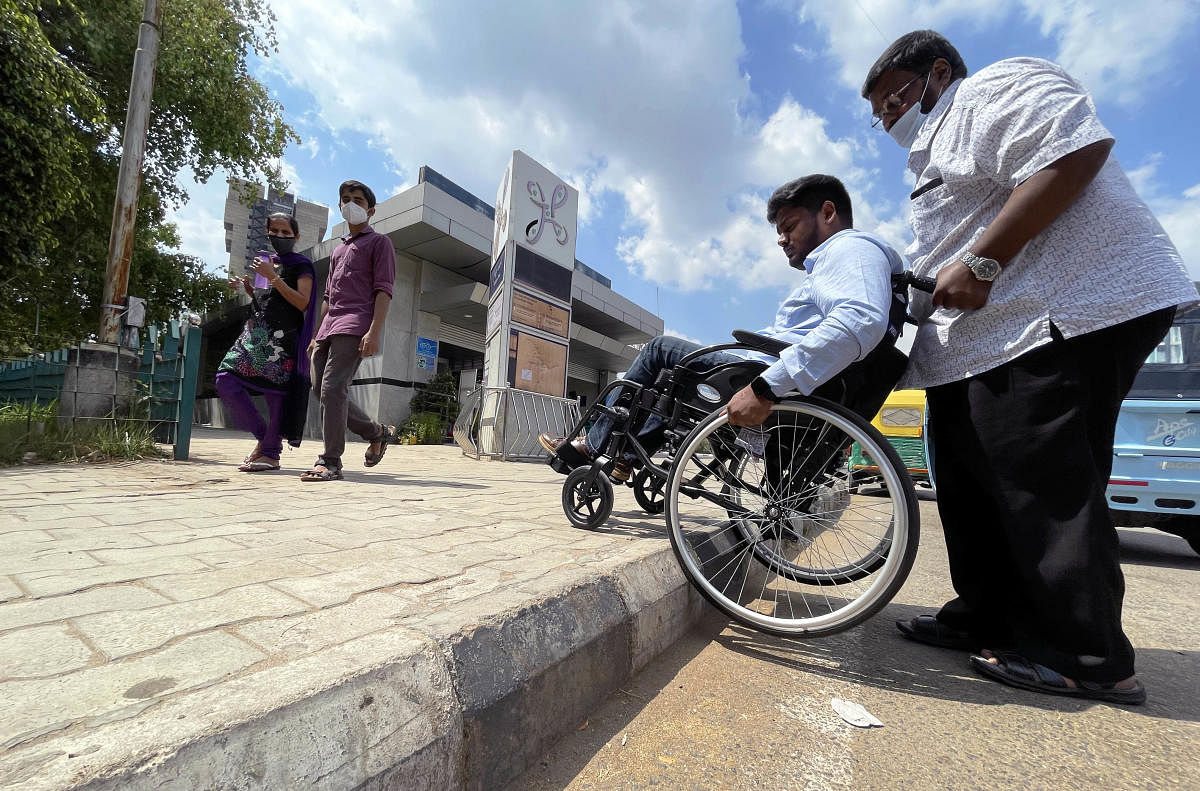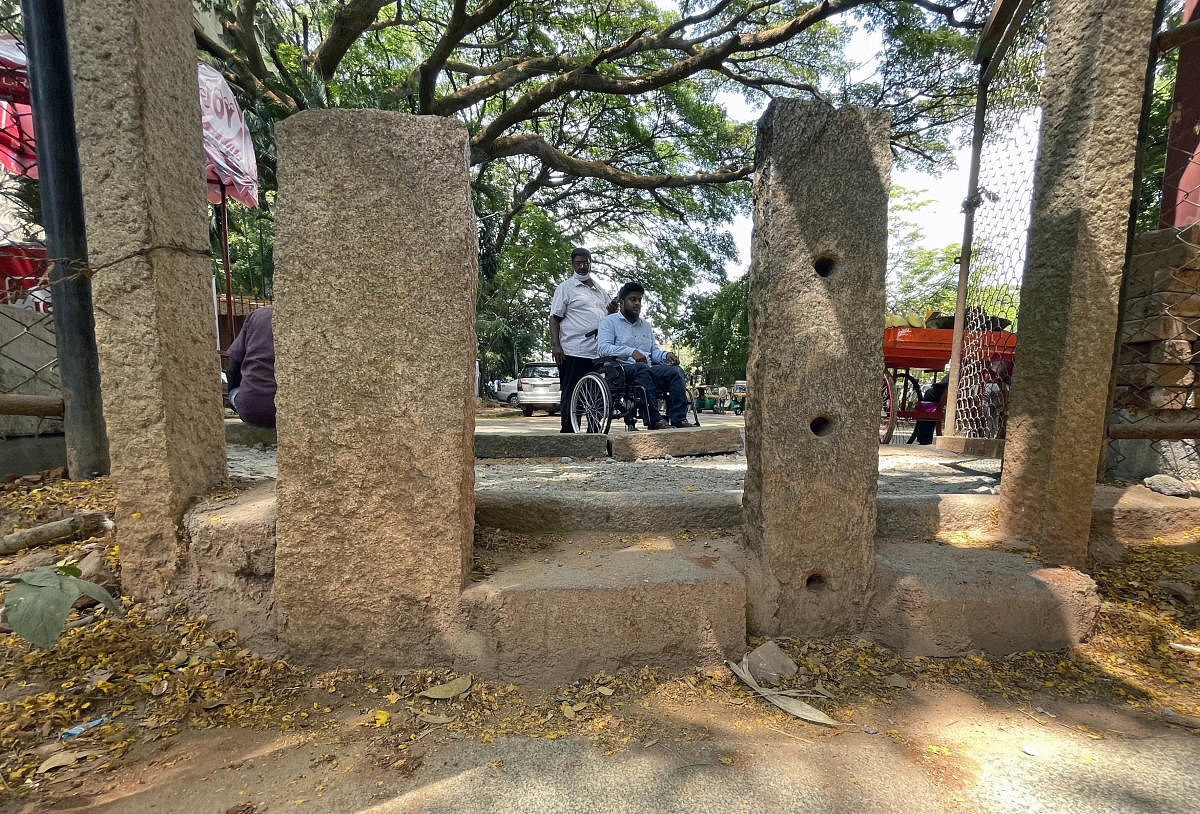

At 28, Sheikh Imran was a non-disabled person in Bengaluru. He had a regular job. He would catch movies regularly, and take weekend trips to Nandi Hills, 61 km away, cruising on his Royal Enfield motorbike.
But life changed last summer, when he lost all mobility from the chest down. He fell from the fourth floor of his apartment in Hebbal Kempapura after developing an epileptic seizure. He suffered a serious spinal cord injury.
Now, he uses a wheelchair and steps out only to go to his office 8 km away, driving a car customised for persons with disabilities (PWD). He works in the marketing team of the Association of People With Disability in St Thomas Town, a job he took up after the accident.
“For 28 years, the hardships of this community, of which I am a part now, never occurred to me,” he says, explaining why he decided to join DHonSaturday on a social experiment to check how a person with disabilities could get around in the city. We split the experiment over two days as Imran was unsure if he would have the physical stamina to travel up and down the city, and cover a bunch of representative locations, in a day.
Before we hit the road, he laid down a condition: “Don’t give me a hand or lift me or push my wheelchair until I ask for it. Your intention may be good but you can do me and others like me more harm than good. I am independent in my wheelchair.”
Day 1
We met Imran at his house. His father S B Shameem, a retired interior decorator, was ready to go with us. He was overjoyed to see his son go out for something other than work for the first time since that tragic fall.
Our first destination was the Baiyappanahalli Metro station, 13 km from their house. As we booked a cab, Imran and his father were wondering if the wheelchair would fit into the trunk. Their fears proved well-founded.
The sedan we had hailed could not accommodate it even after it was folded in half. They had to disassemble it. “Wheelchairs that can be knocked down like this cost at least Rs 20,000 while the others come for Rs 5,000. Most people cannot afford the expensive ones, which is why they find it difficult to commute in cabs,” said Imran.
He got into the front seat on his own. He prefers the front seat as the leg space is bigger there. The driver helped his father pack the wheelchair into the trunk. And we hit the road.
We drove on Outer Ring Road, past a well-known multinational company where Imran used to work as an analyst. “After the accident, the company did not take me back. The HR team never called me back,” he said, visibly upset.
“The corporate policy of many companies insist on employees’ physically fitness. This is a gravely flawed policy,” he continued.
We reached the metro station. As his father and the driver got down to re-assemble his wheelchair, Imran scanned the premises for a ramp or lift to get inside. He spotted neither. By the time we reached the elevator to the platform, he was sweating profusely. Yes, it was a hot day. “Cabs should be allowed till the station building. It is exhausting for people to push the wheelchair during summers even if for five minutes,” he said.
Amenities were no better on the platform. There was no designated area for people with disabilities. So we turned to a security guard, who pointed us to where we could park. There was one place reserved for physically disabled persons on the entire train, the security guard told us. “It is absurd. They have assumed the Metro would be used by just one wheelchair-user at any given time,” Imran rued as the crowd milled around us.
His father did not complain. He smiled and clicked photos as Imran pushed his wheelchair forward into the train, past a door that was wider than the rest. It was Imran’s first time on a metro in a year.
Fifteen minutes later, we were standing outside the Cubbon Park station, looking for a ramp to get down from the footpath and onto the road. There wasn’t one, so his father had to lift him with the wheelchair. Major disappointment was in store. We could not get inside the sprawling park as stone barricades erected at the entry points were too narrow for his wheelchair to pass. Imran was upset. A park he had gone to several times since childhood was now keeping him out.
We abandoned the park plan and decided to head to Church Street instead, 10 minutes away. This time, we hailed a wheelchair-accessible cab via a cab aggregator. “There used to be about 40 wheelchair-friendly cabs on their fleet before, but they have just 25 now,” Imran said. “Also, they charge three times the normal fare,” he pointed out.
The driver cancelled our booking as soon as he accepted it, so we had to hail a regular sedan. It arrived. We disassembled the wheelchair and reassembled it on Church Street. “If wheelchair-users want to travel independently, the small trunk in the cabs is a real hurdle,” Imran said.
Just last year, entrepreneur Prateek Khandelwal installed seven portable ramps that give access to 20 outlets on Church Street in a bid to make Bengaluru’s crowd-favourite spot a bit inclusive for the physically challenged. Prateek also depends on the wheelchair for mobility.
We spotted three ramps on the Street. As for the rest, they were stored inside — the establishment owners take them out on request.
Imran wanted to check out pubs but most were on the first or second floors and were accessible only by stairs, and had no lifts. We then decided to try a cafe. Imran was happy to see a big ramp outside, but his smile disappeared at the sight of the metal detector ahead. It was narrow. Would the wheelchair pass through it? Well, it just got by. No security personnel or cafe staff came forward to assist him.
As we lingered over our pasta, sandwich and fruit juice, Imran opened up about his struggles: “There is a stigma attached to using a wheelchair and people with immobility suffer from depression because of that. I recently turned down an invitation to go out with a coworker (also a wheelchair user). I don’t feel like stepping outside.”
He knows someone who hasn’t left his house in eight years. “Usually, individuals with spinal cord injuries lose control of their lower body. They often use urinary catheters, which they are embarrassed about carrying in public,” he explained.
As we chatted, a lot of glances fell on our table from diners and cafe staff — of curiosity, of concern. Imran’s father, however, was invested in the moment, smiling at his son visiting a cafe for the first time since the accident.
We hung around, reviewing Day 1 of the experiment and chalking out the itinerary for Day 2.
Day 2
We picked up Imran in a cab from his office. The sky was overcast. It could rain any moment. How does a person in a wheelchair wade through water-logged streets? The thought was disturbing but we hoped for the best. We stopped at the iconic Jamia Mosque near K R Market. “I haven’t offered prayers in a mosque in over a year. On a TV news, I saw a man on a wheelchair go inside Jama Masjid in Delhi (one of the largest mosques in India) and I thought I should go too,” Imran said.
There was no ramp at the main entrance to the prayer hall. The adjacent gate has it, we were told. To get there, Imran had to get past two bollards fixed on the pavement. The space between them was just enough for the wheelchair to pass through. He thrust it forward, this time harder, and got to the other side. We reached outside the prayer hall only to find no ramp! “If the largest mosque in the city doesn’t have a ramp, then what hope can I keep from others?” an upset Imran said. He was also feeling “suffocated and alienated” because of the hostile looks he was getting from the sea of people around him.
It started drizzling. We had to rush to the next destination on our plan — a bus ride. We stood at K R Market, the second busiest bus terminal in the city, searching for buses with low footboards. The redesigned BMTC buses weren’t fit for boarding. Not even the Vayu Vajra air-conditioned buses that ply within the city. “A nightmare,” he slammed the service. Ramp access is available on Vayu Vajra buses only along the airport route, authorities concerned told us.
Rain was imminent. We hailed a taxi to go to a mall near Trinity Circle. As the driver helped us disassemble his wheelchair, he told Imran he had never ferried anybody like him before. The small talk took a philosophical turn as the driver said, “You can find ramps in malls but not in places of worship.”
As we drew close to the mall, Imran showed us how the gap between bollards were narrow and pavements were flooded. He saw the city’s infrastructure in a new light, he admitted.
Since assembling his wheelchair would take three to four minutes, we asked the driver to take the cab inside the mall instead of dropping us on the road. The security guard directed us to go to a parking lot, where we would have to pay a fee of Rs 80 an hour. It took us some time to convince him that Imran could not genuinely get off on the road. He came around and we entered the mall.
Imran was observing Ramzan and it was time for iftaar (breaking the fast), so we skipped our plans to watch a film. The theatre was wheelchair-accessible in that Imran could park his wheelchair ahead of the front row. The “good seats” at the back are out of reach, Imran said, rolling his eyes.
It started drizzling, and cabs were difficult to find. What could we do but chat? Imran wasn’t bitter about what he had experienced over two days. “You can’t cure our disabilities, but you can make us feel welcome,” he said.
Watch latest videos by DH here: